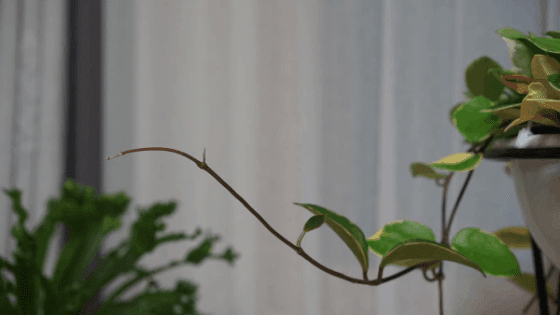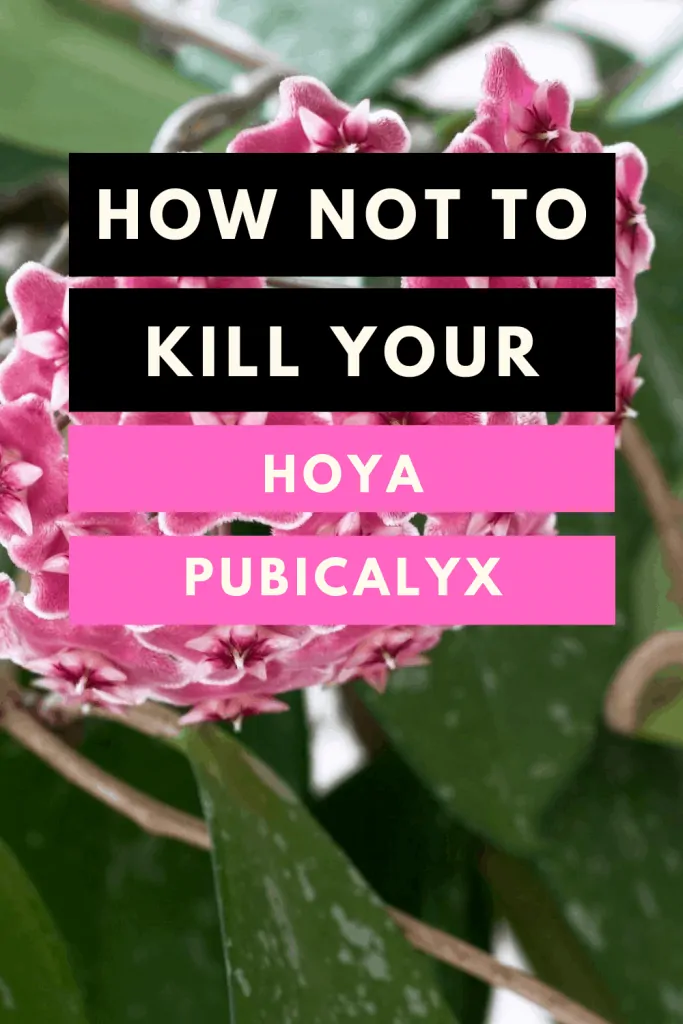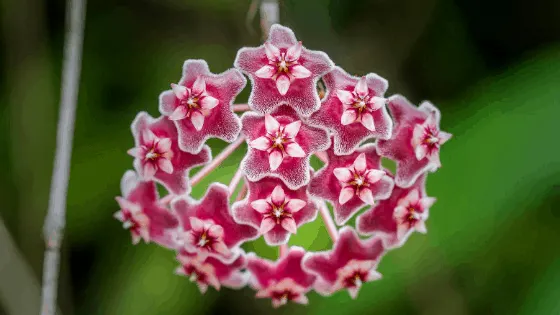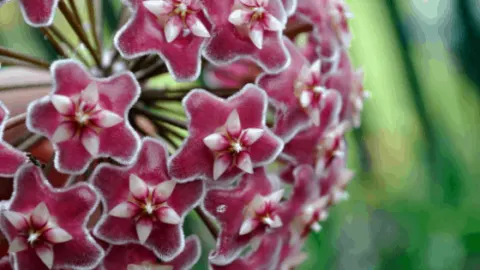Hoya plants are adorned with beautiful flowers in the right environments. Several Hoya species are popular among indoor plant growers, and Hoya Pubicalyx is another no-fuss plant from the Hoya plant series.
The low-maintenance Hoya Pubicalyx plant needs minimal care.
Grow it in a well-draining potting mix or soil with good aeration. Water the Pubicalyx well in the growing season.
But avoid over-watering or soggy soil; it makes the Hoya Pubicalyx vulnerable to root-rot and other fungal diseases.

Hoya Pubicalyx Care
This plant is a flowering climber that belongs to the Apocynaceae family. It is a succulent vine native to the Philippines with beautiful star-shaped fragrant flowers.
With green foliage and dusty pink flowers, Hoya Pubicalyx fills your home with elegance and beauty.
According to NC State University, the correct pronunciation is Hoya (HOY-a) Pubicalyx (pew-bih-KAL-iks).
The Hoya Pubicalyx has been cultivated for years; many gardeners have years old Pubicalyx plants still doing great.
The flowers have a sweet scent that is very noticeable at night. Hoya Pubicalyx produces a natural plant pigment “Anthocyanin” to protect young or soft leaves from intense light.
This pigment is also found in old or mature leaves, which protects them from cold and intense light.
The Hoya Pubicalyx looks beautiful in hanging baskets or terrestrial pots.
Hoya plants have different growth rates depending on the species; Pubicalyx is one of the fastest-growing hoya plants.
The average mature Pubicalyx plant is approximately 8 to 10 feet (3 m) in height.
The leaves are narrow and about 5 to 12 cm long and 6 cm wide.
This plant is also referred to as a wax plant because of the thick, glossy leaves.
Many plant lovers believe that Hoya plants are the easiest to care for as houseplants.
If you are also impressed by the praise of Hoya plants and wondering how to care for the Hoya Pubicalyx, we have covered the basic care guide for you in this article.
Table of Contents
Varieties of Hoya Pubicalyx
Hoya Pubicalyx has several cultivars or varieties; they are differentiated based on the color of flowers and foliage. Some of them are:
Pink Silver: This cultivar has green leaves with silver splashes. The leaves turn pinkish silver in sunlight, hence the name Pink-Silver. The flowers of this plant are light red with small pink centers.
Black Dragon: The leaves of this cultivar are lime green with no marks. The flowers are black colored with a red center. This plant blooms well even under grow lights.
Red Buttons: The flowers for this variety are dark purple with a reddish center. This plant also has red and purple blotches on the green leaves.
Royal Hawaiian Purple: This one has green leaves with silver or greyish patterns. It has pinkish-red or black star-shaped flowers in clusters.
Some other popular cultivars include Bright One, Dapple Gray, Jungle Garden, Silver Sheen, etc.

How not to kill your Hoya Pubicalyx
Hoya Pubicalyx Plant Care Guide
All the Hoya Pubicalyx varieties have the same plant care requirements. The essential care instructions are discussed below:
Soil
Use a light, airy, and well-drained soil mixture for the Hoya Pubicalyx plant.
Use rich soil with high organic content and nutrients for a better root system.
Plant the Hoya Pubicalyx in loamy, fast-draining soil or potting mixture.
The ideal soil pH for Pubicalyx is from 6.5 to 7.5, i.e., slightly acidic to neutral.
You can make your own potting mix by using one part orchid bark, one part coarse perlite, and one part peat-free compost.
Or you can use cactus compost, but you will have to add some extra perlite to improve drainage.
Watering
Watering a Hoya Pubicalyx plant is the same as watering any other Hoya plant species.
Hoya Pubicalyx is also a drought-tolerant houseplant. But you have to water the plant regularly in the growing season.
Monitor the moisture level in soil and water the plant when the top 2 inches are dry.
Check the top of the soil regularly; if it is dry, your Hoya Pubicalyx needs to be watered again.
I would recommend using soft water (rainwater or filtered water) to water this plant.
This plant requires moderate watering, in general, the average watering rate is three times per week in summer and once a week in winter.
But you may have to adjust the watering schedule based on the light they are receiving.
Light and temperature conditions impact the water requirement. High temperature and light exposure mean the plant will require more water.
If you have planted the Hoya Pubicalyx in heavy soil such as a peaty mix, it is better to water the plant mildly.
However, in case of a lighter soil mixture, water the plant deeply until the water starts flowing from the drainage holes.
Don’t allow the Hoya Pubicalyx plant to sit in standing water except when you have to thoroughly saturate the soil.
Discard any excess water in the tray after saturating the soil.
Pubicalyx is an easy to grow and rewarding plant that is tough and forgiving if you forget to water your plant once or twice.
If your Hoya Pubicalyx starts dropping its leaves, it is being overwatered.
This plant does not like soggy soil at all, therefore avoid overwatering to protect the plant from root-rot.
Light
Hoya Pubicalyx enjoys medium to bright but indirect sunlight. They grow well in a bright light location, such as close to a sunny window.
You can grow this plant in natural sunlight or artificial indoor plant lights as well.
If you are going to grow the Pubicalyx outdoors, protect it from direct sunlight by covering the plant with shade cloth.
Avoid keeping the plant in direct sunlight during peak hours as it will scorch the foliage and flowers.
For healthy growth and blooming, the plant needs at least 6 hours of sunlight every day.
Mostly gardeners recommended an hour or two of early morning direct sunlight to help the plant grow beautiful foliage.
Because the more light the plant gets, the more vibrant the foliage and the more blooms it produces.
Temperature
Keep the plant in indoor places with temperature ranging from 60 to 75 o F (15 to 25 degrees Celsius).
As a tropical plant, the Hoya Pubicalyx does not handle frost well, therefore do not place the plant in temperatures below 10 oF as the growth will stop.
In winter also, the minimum temperature should not be less than 50 oF ( 10 degrees Celsius).
For outdoor planting, USDA hardiness zones 10 b to 11b are recommended.
Humidity
Being a tropical plant, Hoya Pubicalyx is a humidity lover. About 70% or at least 60% humidity level in the air is suitable for this plant.
For excessively dry climate, keep the plant near a humidifier.
Mist the plant leaves using water from a spray bottle.
When this water evaporates, it will create moisture around the Hoya Pubicalyx.
Don’t mist the Hoya Pubicalyx when its budding or flowering.
But remember that with high humidity, the plant needs less water. So check the plant before watering to prevent overwatering.
Keep the plant away from vents, heaters, or air conditioners.
Fertilizer
Just like other Hoya species, Pubicalyx is also not a heavy feeder, but the plant will appreciate some extra added nutrition in the active growing season.
I would suggest fertilizing the plant using liquid fertilizer. Use a fertilizer high in potassium and spray it on the leaves as well to encourage flowering.
You can also give a monthly dose of compost tea or a dilute fish emulsion.
You can add any balanced organic or a diluted synthetic fertilizer. As a protip, fertilize the plant in the blooming season to increase the flowers.
Avoid fertilizing the plant in winter months because it enters a semi-dormant state in winter.
Professional gardeners recommend fertilizing the houseplants at least once or twice a year.
Before adding any fertilizer, always make sure the soil is damp. Never add fertilizer to a dry potting mixture or soil.
Potting
Hoya Pubicalyx is a vigorously growing vining plant with deep green leaves that gracefully spread over the sides of its pot.
But these plants prefer to be root-bound; therefore, repotting is not required often.
As an epiphytic plant, Hoya Pubicalyx needs good drainage. You can use some vertical support to help the plant climb upwards.
Most Gardeners recommend terracotta pots with drainage holes for growing Hoya Pubicalyx.
You should avoid large containers to facilitate the plant in staying root-bound.
Read my article about where to get the best planters online.
If you consider buying a terracotta pot I also summarized the advantages and disadvantages of terracotta pots here.
Blooms
The dusty pink star-shaped flowers have a light-pink central star and a maroon center. Each flower is around 0.4 cm in size.
Numerous tiny pink flowers form bouquet-like clusters.
The bouquet grows on peduncle tips and is connected with the main stem via a tiny stem-like structure.

Hoya Pubicalyx Star-Shaped Wax Flower
The flowering season for Hoya Pubicalyx cultivars is from late spring to late summer. The flowers have a strong fragrance, especially at night.
The waxy flowers grow on tiny stalks less than an inch in length.
Depending on the cultivar, the plant can take 1-2 years to start blooming.
The color of the flower varies; each plant comes with a different color ranging from shades of pink, red, and purple.
Do not remove the stalks after the blooming season is over. It will delay blooming; the old stalks will help the plant grow new flowers.
It will also save the plants energy that will be otherwise invested in growing new stalks.
Avoid touching the new stems of the plant because they are sensitive, and it may delay flowering.
Blooming significantly depends on the amount of sunlight the plant receives.
Pruning
Hoya Pubicalyx is a low-maintenance houseplant that requires little or no pruning.
The ideal time to prune the Pubicalyx plant is in the summer or spring season.
I would recommend pruning the plant after the blooming season is over.
You can trim some leaves from the lower part of the plant to enhance the overall appearance of the plant.
If the plant is growing very large, prune some parts of the plant and propagate them for new growth in a separate pot.
While pruning, remove the dead or yellow leaves and damaged stems. You should always wear gloves; the white sap from the plant can cause allergy.
Propagation
The Hoya Pubicalyx can be easily propagated using stem cutting or leaf cuttings.
The best time for propagation is during the active growing season, i.e., summer and spring.
I would recommend taking cuttings in early spring; this will allow the plant to root in the growing season and help it survive.
- Always use a pair of sterilized pruning shears or scissors; you can sterilize your garden tools using isopropyl alcohol.
- Take a 5 to 7-inch cutting from the growing end of the stalk with nodes.
- Remove the leaves from the lower end.
- Place the cutting in the shade for some time to let the tissue heal.
- Now plant the cutting keeping the nodes under the soil medium at least 4 inches deep.
- Water the soil generously, about thrice a week. Always keep the soil mildly moist until new growth is seen.
- Place the plant in a warm and humid place with indirect sunlight light.
- Usually, the root development starts in three to four weeks.
- You can repot the newly propagated plant after the cuttings have rooted.
- Choose a sunny location with partial shade to protect the newly grown foliage from burning.
You can use a plastic bag or zip lock method to propagate Hoya Pubicalyx. You can place the cutting in sphagnum moss or potting soil.
This method creates a contained green-house environment for the Pubicalyx plant.
Growing from seeds
Hoya Pubicalyx plant can also be grown from seeds, store the seeds in a dark and dry location.
Sow the fresh seeds in peat moss soil mixture. Provide high humidity and lots of light for the seeds to start germinating.
During the daytime, the temperature should be around 25 degrees Celsius (77 oF).
For better results, sow the seeds of Hoya Pubicalyx indoors or in a greenhouse at the end of spring or in early autumn.
Keep the soil moist by watering regularly. You should cover the pot or container with a plastic bag to protect the new plant from the wind or cold.
Germination can take 2-5 weeks, depending on the environment provided.
Common pest and diseases for Hoya Pubicalyx
Hoya Pubicalyx is an easy-going, rewarding and long-lasting addition to container gardens of your porch or patio or windowsill.
But you have watch out for certain pests that might infect your Hoya Pubicalyx plant and damage the beautiful foliage or flowers.
The sweet-smelling flowers can attract different bugs and pests:
Mealybugs
Mealybugs are one of the common pests that can infest almost every species of Hoya.
You can use a houseplant insecticide, put it in the potting soil while potting the plant to keep the mealybugs away from the beautiful Hoya Pubicalyx.
Spray the plant with neem oil regularly. You can also use isopropyl alcohol to treat mealy bugs.
Use a Q-tip dipped in the isopropyl alcohol to wipe the infected areas of the plant.
Aphids
Aphids are another common houseplant pest found on Hoya plants. These tiny insects are found on the back of leaves, on flower buds, or the base of the stems.
Aphids can be sprayed off the plant with a gentle stream of water from a hose.
You can also use insecticidal soap or spray to take care of the aphid infestations.
You can make a homemade aphid spray by mixing a few tablespoons of liquid soap with water.
Apply the spray on the affected parts of the plant. The soap will dissolve the protective outer layer of aphids, eventually killing them.
Whiteflies
Whiteflies are small, sap-sucking insects that infest indoor plants, especially during warm weather.
They can cause the leaves to turn yellow, dry or fall off the plant.
The best approach is to prevent the whiteflies from developing in your indoor garden.
You can use yellow sticky traps to monitor and control the whitefly’s population. Insecticidal soaps or oils can also help reduce the whiteflies.
Root-rot nematode
The worst pest that is going to trouble your Hoya Pubicalyx plant is the root-knot nematode.
If your plant health is declining and your plant is showing symptoms such as wilting, yellowing or stunting it is probably infected with the root-knot nematode.
These insects thrive in areas that have warm temperatures. If you leave the plant untreated, it will eventually die because of the nematodes.
If your plant is heavily infested, you can take a cutting from the top of the plant and propagate it to grow a new healthy plant.
The nematodes will damage the root system of the plant affecting the growth of the plant.
Separate the nematode-infested plants and destroy them if heavily infested to prevent the spread of infection to other plants.
Necessary control steps for nematodes should be taken before planting or seeding.
Adding organic matter such as composted leaves or manure will encourage the biological control of nematodes.
Tips for Hoya Pubicalyx
- When propagating in water, after 1 or 2 inches of roots have developed transplant the cutting to a potting medium. Otherwise, the roots will adapt to being in the water, and the plant will have water-roots that are weaker than soil-roots.
- If you let your Hoya dry out for too long or forget to water it, try not to flood it with water on your next watering. Give a small quantity of water to the plant at a greater frequency.
Frequently asked questions about Hoya Pubicalyx
Is Hoya Pubicalyx toxic?
Hoya Pubicalyx plants have a milk-like fluid inside them that is toxic in nature.
Consuming or coming in contact with the white sap can cause health issues or allergies.
Therefore, it is better to keep the plant away from children or pets.
How to train hoya plants to grow along a path?
These vine plants can be trained to grow along any path; they can climb hanging planter, trees, or any wall in your home.
These vines can grow up to 20 feet long with proper training.
Use bamboo or any other vertical support in the middle of the pot and tie the plant with it using twine or strings.
The best time to train the hoya plant is when it is young.
Why is my Hoya Pubicalyx plant not blooming?
The most common reason for no blooms in Hoya Pubicalyx is the light deficiency.
Always make sure the plant is receiving plenty of sunlight.
Sometimes changing the position or transplanting can also prevent the plant from blooming.
Moving the plant will disturb it and cause it to drop the buds before they open.
What is the best type of growing soil for Hoya Pubicalyx?
The best soil for Hoya Pubicalyx Splash Plants is a well-balanced mixture of peat moss, perlite, and vermiculite that dries between watering but does not compact quickly.
You can add a slow-release granular fertilizer to help the plant in the transplanting transition.
How can I remove hard water spots from hoya Pubicalyx leaves?
You can use 1 teaspoon of white or red vinegar with a pint of warm water to remove water spots from the leaves.
Dip a small piece of cloth in the solution and rub the leaves gently in a circular motion.
Rinse with clean water and dry the leaves using another cloth.
How many hours of lighting are required if I’m growing the hoya Pubicalyx under artificial lights?
Your plant needs at least 12 to 14 hours of indoor artificial lights per day.
And if you want the plant to bloom, provide up to 16 hours of light.
These plants also need a small period of darkness similar to that in their natural habitat.
Conclusion
This air plant with succulent leaves is an excellent houseplant for beginners, as it is easy to care for and drought tolerant.
The tropical Hoya Pubicalyx plants do not need extra care beyond well-draining soil and warm, humid conditions.
The best thing about Hoya plants is the waxy out of this world star-shaped flowers that are just to die for.
If you liked your article, please share it on Pinterest and follow our Facebook group for plant care based discussions and best practices.


